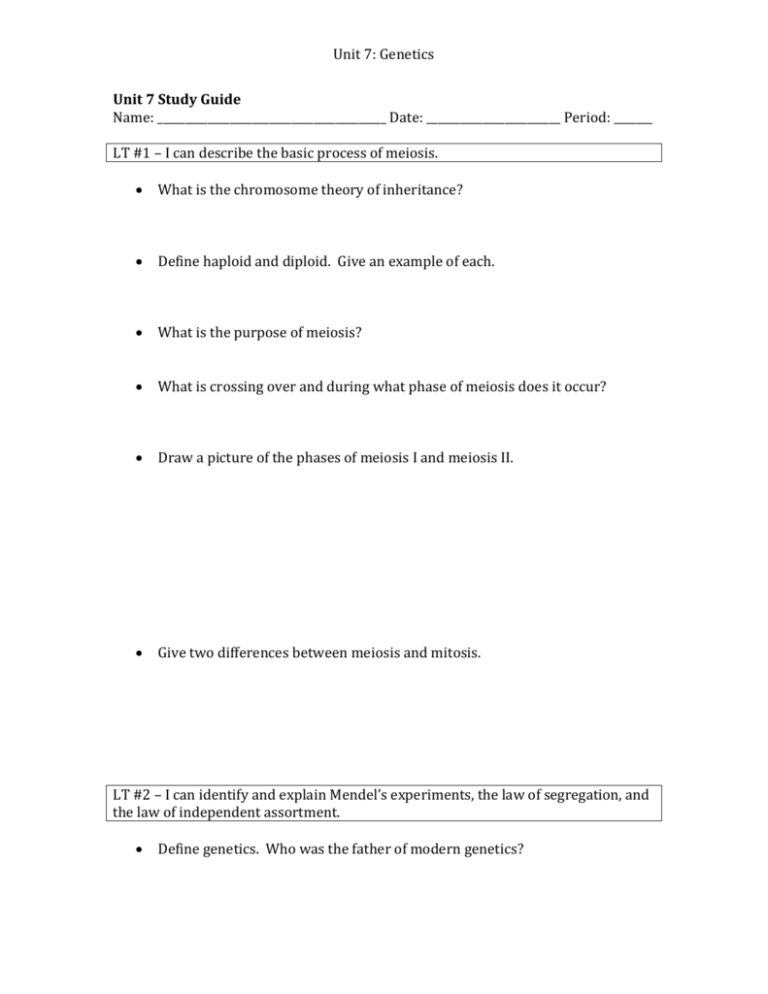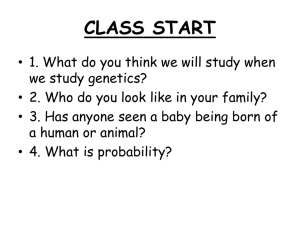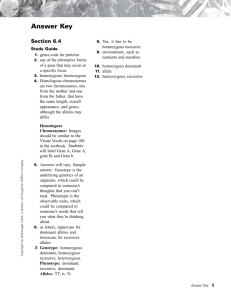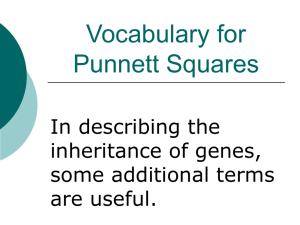Unit 7: Genetics Unit 7 Study Guide Name: Date: Period: ______ LT
advertisement

Unit 7: Genetics Unit 7 Study Guide Name: _________________________________________ Date: ________________________ Period: _______ LT #1 – I can describe the basic process of meiosis. What is the chromosome theory of inheritance? Define haploid and diploid. Give an example of each. What is the purpose of meiosis? What is crossing over and during what phase of meiosis does it occur? Draw a picture of the phases of meiosis I and meiosis II. Give two differences between meiosis and mitosis. LT #2 – I can identify and explain Mendel’s experiments, the law of segregation, and the law of independent assortment. Define genetics. Who was the father of modern genetics? Unit 7: Genetics What is cross pollination and how did Mendel use it? Define allele. What is the principal of dominance? Define Mendel’s law of segregation. Define Mendel’s law of independent assortment. LT #3 – I can define and provide examples of the following: genotype, phenotype, dominant allele, recessive allele, homozygous, and heterozygous. What is a genotype? What is a Phenotype? Describe each of the following genotypes: o TT o Tt o Tt LT #4 - I can construct and interpret Punnett squares. In pea plants, tall (T) is dominant over short (t). Cross two heterozygous pea plants and give the phenotypic and genotypic ratios. Unit 7: Genetics In pea plants, there are two alleles for seed texture (R = round and r = wrinkled) and two alleles for seed color (Y = yellow and y = green). A plant that is heterozygous for seed texture and homozygous recessive for seed color is crossed with a pea plant that is homozygous dominant for seed texture and homozygous recessive for seed color. How many of the predicted offspring will be wrinkled and yellow? LT #5 - I can define and provide examples of complex inheritance patterns (codominant alleles, incompletely dominant alleles, multiple alleles, and polygenic traits). Compare codominance and incomplete dominance. Describe how these inheritance patterns work if true-breeding red and white flowers are crossed. In humans, there are four blood types: Type A, B, AB, and O. The alleles A and B are codominant to each other and the O allele is recessive to both A and B alleles. If a person with Type B blood marries someone with AB blood, what Unit 7: Genetics is there a possibility that the offspring will have type O blood? Why or why not? Define polygenic trait. Give some examples. LT #6 – I can construct and interpret pedigree charts and karyotypes. Draw what would be on the pedigree chart if a female is homozygous normal (does not have the trait) Draw what would be on the pedigree chart if a male is homozygous for a trait. Draw what would be on the pedigree chart if a male is heterozygous for a trait. (what would this be called) Albinism is an autosomal recessive disorder. Complete the following pedigree: Two normally-pigmented parents have 3 children. The first child (a girl) and their second child (a boy) have normal pigmentation. Their third child (a girl) has albinism. That girl marries a normally pigmented male and they have four children. The first three (two girls and a boy) have normal pigmentation. Their fourth child (a girl) has albinism like her mother. Unit 7: Genetics Find the issue in the karyotype below. What is the difference between autosomes and sex chromosomes? How many of each do humans have? LT #7 – I can describe the mode of inheritance in commonly inherited disorders. If a disorder is dominant, which genotypes would be affected? (Yes or no) o Homozygous Dominant o Heterozygous o Homozygous Recessive o In humans, acondroplasia “dwarfism” (D) is a dominant over normal (d). A homozygous dominant (DD) dies before the age of one. A heterozygous (Dd) person is dwarfed. A homozygous recessive (dd) individual is normal. A heterozygous dwarf man marries a dwarf heterozygous woman, what is the probablitly that they will have a baby that dies before the age of one? Unit 7: Genetics LT #8 – I can explain sex-linked inheritance. Define sex-linked genes. Which chromosome is larger, the X or the Y? XX are __________________ and XY are ___________. Colorblindness is a recessive sex-linked disorder. If a mother that is a carrier for colorblindness and her husband, who has normal vision, have children. How many of their daughters will be carriers for the disorder?








